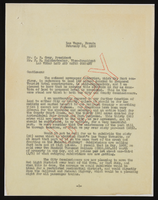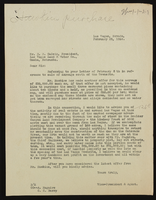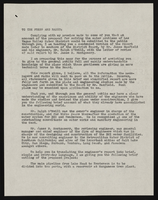Search the Special Collections and Archives Portal
Search Results
Legal disputes, 1947-1976
Level of Description
Scope and Contents
The legal disputes series is largely composed of reference files of newspaper clippings dating from 1947-1976, as well as some legal documents. Over the course of Howard Hughes’ life he and his companies were involved in a large number of legal disputes, investigations, and hearings. This series contains material on Hughes appearance before the Senate Hearings of 1947, the political fight to build Dodger stadium in Chavez Ravine (Los Angeles, California) in the mid-1950s, the Oil Lease Probe of 1957, Hughes’ fight for control of TWA and Air West, and Clifford Irving and his publisher McGraw-Hill. A number of smaller legal disputes are also documented. Several of these involved trusted aides such as Noah Dietrich, John Meier, and Robert Mahue. However, it should be noted that legal disputes, investigations, and hearings related to RKO and HUAC are included in Series V.
Archival Collection
Collection Name: Howard Hughes Public Relations Reference Files
Box/Folder: N/A
Archival Component
Harvard Project on American Indian Economic Development (HPAIED) files, 1990-2010
Level of Description
Scope and Contents
The Harvard Project on American Indian Economic Development (HPAIED) files document the HPAIED’s efforts to research the socioeconomic impacts of Native American gaming from 1990 to 2010, with the bulk of materials dating from 2000 to 2005. The materials in this subseries document Dr. Spilde’s research while working for the HPAIED, offering valuable insight into the administration of the organization. The subseries includes materials collected by Dr. Spilde about HPAIED, the ᏣᎳᎩᎯ ᎠᏰᎵ (Cherokee Nation), the Choctaw Nation of Oklahoma, and the Mvskoke (Muscogee [Creek] Nation). Also included are socioeconomic reports, NIGA reports, site visit reports, notes, HPAIED studies, essays, “Honoring Nations” HPAIED awards program materials, Harvard University promotional materials, research proposals, Oklahoma Indian Gaming Association materials, census data, bibliographies, informational booklets and packets, conference materials, and newspaper articles.
Archival Collection
Collection Name: Katherine A. Spilde Papers on Native American Gaming
Box/Folder: N/A
Archival Component
University of California, Riverside (UCR) files, 1998-2009
Level of Description
Scope and Contents
The University of California, Riverside (UCR) files contain materials about the UCR California Center for Native Nations, a research center that focuses on the preservation of California Native American history, culture, language, and sovereignty. Materials focus on Native American gaming, problem gambling, federal recognition of Native American communities, trust land issues, and off-reservation casinos. The subseries dates from approximately 1998 to 2009, with the bulk of materials dating from 2004 to 2007. The materials include socioeconomic reports, congressional legislation, federal law summaries, Federal Register entries, NCAI correspondence, Dr. Spilde’s notes, newsletters, agendas, correspondence, UCR periodicals, conference booklets, informational packets, journal articles, and newspaper articles. The materials document Dr. Spilde’s research while working at UCR, and also the issues of problem gambling, Native American federal recognition, and trust land issues.
Archival Collection
Collection Name: Katherine A. Spilde Papers on Native American Gaming
Box/Folder: N/A
Archival Component
Scarface, 1930 to 1963, 1930 to 1935
Level of Description
Scope and Contents
The Scarface sub-series (1930-1963) is comprised of materials pertaining to the production process and censorship issues of The Caddo Company's April 9, 1932 release of Scarface, also known as Scarface: The Shame of the Nation. The materials in this sub-series consist of administrative, advertising and publicity, distribution, editing, legal, and production and direction, and story development records. Types of materials include newspaper clipping bound volumes, correspondence, forewards, contracts, and reports. Also included are black-and-white photographic prints and negatives depicting the film during its production, sets, director activities, and profile images of the principal and supporting cast used for publicity.
Scarface is based on Armitage Trail's novel of the same name. The film, loosely based on Al Capone, faced a censorship battle that Howard Hughes employed in the film's promotion.
Archival Collection
Collection Name: Howard Hughes Film Production Records
Box/Folder: N/A
Archival Component
Ethlyn Barneby oral history interview
Identifier
Abstract
Oral history interview with Ethlyn Barneby conducted by Claytee White on October 16, 2002 for the Boyer Early Las Vegas Oral History Project. During this interview Barneby discusses her experiences as a resident of Boulder City, Nevada during the 1940s. Barneby also discusses life with her husband, a member of the National Guard, and her husband’s employment as an operator for the City of Los Angeles, California during the construction of the Hoover Dam. She also describes their experiences moving back and forth between Boulder City and Los Angeles as well as the growth of Boulder City in relation to Las Vegas, Nevada.
Archival Collection





